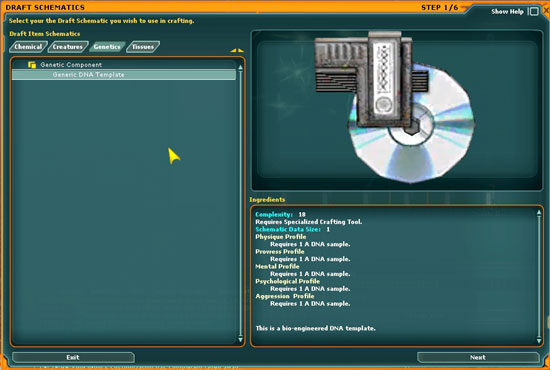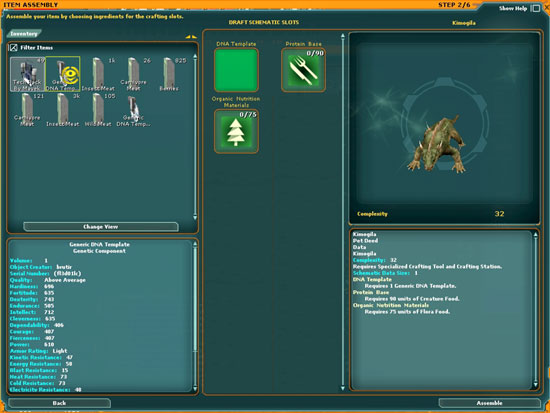|
Chapter 3: Breeding
The Breeding skill tree represents a Bio-Engineer's ability to create cloned creatures. The Clone Engineering skill tree grants a Bio-Engineer the ability to clone diverse and dangerous creatures and requires Bio-Engineering Crafting Experience.
Clone Engineering 1
Skill Mods: None
Commands and Abilities Granted:
Clones: Bageraset, Cu Pa, Dewback, Gualama, Gurnaset, Huurton, Kahmurra, Krahbu, Kwi, Mott, Roba, Tybis, Verne
Clone Engineering 2
Skill Mods: None
Commands and Abilities Granted:
Clones: Boarwolf, Bocatt, Carrion Spat, Choku, Dune Lizard, Gurrcat, Kima, Kusak, Langlatch, Pugoriss, Vesp , Zucca Boar
Clone Engineering 3
Skill Mods: None
Commands and Abilities Granted
Bantha, Blurrg, Bol, Bolle Bol, Bolma, Bordok, Brackaset, Falumpaset, Gronda, Piket
Ronto, Snorbal, Thune
Clone Engineering 4
Title Granted: Breeder
Skill Mods: None
Commands and Abilities Granted
Angler, Dalyrake, Guf Drolg, Gurreck, Hermit Spider, Kliknik, Mawgax, Merek
Narglatch, Razor Cat, Shear Mite, Slice Hound

Bio-Engineering cloned creatures starts with understanding the schematics and the ingredients. Creature clones are schematics with three basic slots: Generic DNA Template, A Protein Base and Organic Nutrition Materials. The Generic DNA Template is a component that is required for every creature and looks like a disk and a data reader. As you progress up the Clone Engineering tree, you will be granted additional creature skins. These templates all look exactly the same, except for their corresponding creature names (Squall, Bantha etc.). The "Protein Base" is basically creature food and that means meat, eggs and milk; though, generally it's a good idea to stick to the meat. Meat is harvested from creatures with the Scout skills, but remember that if a creature keels over because you've "sampled" it, you cannot harvest the meat. Organic Nutrition is fulfilled with flora components and that is basically any organic that sounds edible; wheat, beans, berries, flowers and all things vegetable fall into this category. Depending on your chosen skill set, you can either forage and survey for them or shop for them on the bazaar. Another great place to find good deals on these kinds of resources is by using the Trade Forums.
Creature Cloning
Creating Bio-Engineered pets is the science of crafting creature clones. In practice, creature cloning is the process of taking the DNA that you gather in the field and using it to create a Generic DNA Template. This DNA Template is what determines the characteristics of the final clone; i.e., HAM, armor, attack resistances, damage, attack speed, chance to hit, special attacks, ranged attacks, and the creature's "creature level". The DNA template is then combined with the Flora and Meat resources in a clone schematic. Additional Clone schematics are granted as the bio-engineer develops his craft and progresses up the skill trees. In every case, you will have to sample at least 5 units of DNA. These proverbial knobs a bio-engineer can turn to experiment with are the 5 DNA sample slots in the creature schematic. The quality of the sample is an important factor as well as how you spend your experimentation points in the process. 5 DNA samples, 5 slots and many potential possibilities.
Cloning Experimentation
Creature experimentation is a complex process of making decisions about what kind of creature you want to create. Experimentation is part of the process and can be quite a challenge, so belly up to your Food and Chemical crafting station and put your thinking cap on. This guide will go over some of the basic elements to the experimentation process without spoiling the potential fun of discovery along the way.
The elements of this part of the process are your samples and your experimentation points. You must take your DNA samples and place them in the 5 slots of your crafting schematic. Each of these slots represents a characteristic of the creature, and every template has five profile slots: Aggression, Mental, Physique, Prowess and Psychological. Each of these profiles represents aspects of a creature's pool of characteristics and will ultimately make up the nature of the beast. Creature experimentation represents a very challenging crafting experience with many possibilities. Each of the five profiles are interrelated and depending on how you experiment with them will effect the outcome of a creature's attributes, HAM pools, damage and to-hit, etc. Experimentation will have very little effect on resists, but it can make the difference in whether or not your clone gets, for example, armor. You accomplish this by experimenting with the 5 experimentation attributes corresponding to the 5 profile slots. Your choice of skin will determine a creature's base movement speed, minimum creature level and aggressiveness. This is an especially important aspect to consider because it will effect who can potentially be a user/buyer for the beast. Anything CL10 and under can be used by any player as long as it is non-aggressive. Any result over CL10 will require creature-handling skills for it to be used and this includes the Bio-Engineer that creates the creature.
A good thing to watch while you are choosing where to place your experimentation points is the little percentage number in the lower right hand side of the crafting window. This number will increase and decrease depending on how you place your experimentation points and represents your chance at a critical failure. Notice which combinations and concentrations of points will put you at risk and which will not. It should also be said that the quality of your crafting station is key at this point in the process. Once you have chosen your experimentation variables, you will get the option to choose a customized color for your creature and the option to customize the name of your creature.
The next horizon is "Generational Creation". Bio-Engineers can even take DNA samples from creatures that they have cloned and that other Bio-Engineers have cloned. Just remember that, with each generation, a sample has a reduction in its maximum potential. Generational cloning can be used to breed out undesirable traits or recycle failed experiments where the creature level was higher than desired.
When you truly begin to master the profession, you will be able to control creature characteristics and cause some interesting and powerful results to your experiments. A master using good DNA and placing it properly with quality resources can routinely get increased results over wild versions and can be made with higher damage, and all sorts of variations depending on your choices throughout the process.

Previous|Index|Next
|
